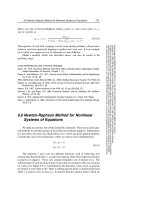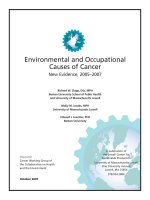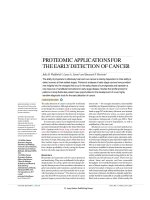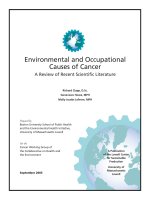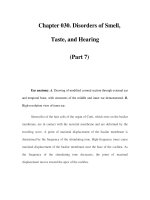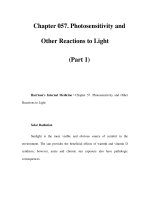Chapter 078. Prevention and Early Detection of Cancer (Part 7) pps
Bạn đang xem bản rút gọn của tài liệu. Xem và tải ngay bản đầy đủ của tài liệu tại đây (13.38 KB, 5 trang )
Chapter 078. Prevention and Early
Detection of Cancer
(Part 7)
Potential Biases of Screening Tests
The common biases of screening are lead time, length-biased sampling, and
selection. These biases can make a screening test seem beneficial when actually it
is not (or even causes net harm). Whether beneficial or not, screening can create
the false impression of an epidemic by increasing the number of cancers
diagnosed. It can also produce a shift in proportion of patients diagnosed at an
early stage that improves survival statistics without reducing mortality (i.e., the
number of deaths from a given cancer relative to the number of those at risk for
the cancer). In such a case, the apparent duration of survival (measured from date
of diagnosis) increases without lives being saved or life expectancy changed.
Lead-time bias occurs when a test does not influence the natural history of
the disease; the patient is merely diagnosed at an earlier date. When lead-time bias
occurs, survival appears increased, but life is not really prolonged. The screening
test only prolongs the time the subject is aware of the disease and spends as a
patient.
Length-biased sampling occurs when slow-growing, less aggressive cancers
are detected during screening. Cancers diagnosed due to the onset of symptoms
between scheduled screenings are on average more aggressive, and treatment
outcomes are not as favorable. An extreme form of length bias sampling is termed
overdiagnosis, the detection of "pseudo disease." The reservoir of some
undetected slow-growing tumors is large. Many of these tumors fulfill the
histologic criteria of cancer but will never become clinically significant or cause
death. This problem is compounded by the fact that the most common cancers
appear most frequently at ages when competing causes of death are more frequent.
Selection bias must be considered in assessing the results of any screening
effort. The population most likely to seek screening may differ from the general
population to which the screening test might be applied. The individuals screened
may have volunteered because of a particular risk factor not found in the general
population, such as a strong family history. In general, volunteers for studies are
more health conscious and likely to have a better prognosis or lower mortality rate,
irrespective of the screening result. This is termed the healthy volunteer effect.
Potential Drawbacks of Screening
Risks associated with screening include harm caused by the screening
intervention itself, harm due to the further investigation of persons with positive
tests (both true and false positives), and harm from the treatment of persons with a
true-positive result, even if life is extended by treatment. The diagnosis and
treatment of cancers that would never have caused medical problems can lead to
the harm of unnecessary treatment and give patients the anxiety of a cancer
diagnosis. The psychosocial impact of cancer screening can also be substantial
when applied to the entire population.
Assessment of Screening Tests
Good clinical trial design can offset some biases of screening and
demonstrate the relative risks and benefits of a screening test. A randomized,
controlled screening trial with cause-specific mortality as the endpoint provides
the strongest support for a screening intervention. Overall survival should also be
reported to detect an adverse effect of screening and treatment on other disease
outcomes (e.g., cardiovascular disease). In a randomized trial, two like populations
are randomly established. One is given the medical standard of care (which may
be no screening at all) and the other receives the screening intervention being
assessed. The two populations are compared over time. Efficacy for the population
studied is established when the group receiving the screening test has a better
cause-specific mortality rate than the control group. Studies showing a reduction
in the incidence of advanced-stage disease, an improved survival, or a stage shift
are weaker (and possibly misleading) evidence of benefit. These latter criteria are
necessary but not sufficient to establish the value of a screening test.
Although a randomized, controlled screening trial provides the strongest
evidence to support a screening test, it is not perfect. Unless the trial is population-
based, it does not remove the question of generalizability to the target population.
Screening trials generally involve thousands of persons and last for years. Less
definitive study designs are therefore often used to estimate the effectiveness of
screening practices. After a randomized controlled clinical trial, in descending
order of strength, evidence may be derived from the findings of internally
controlled trials using intervention allocation methods other than randomization
(e.g., allocation by birth date, date of clinic visit); the findings of cohort or case-
control analytic observational studies; the results of multiple time series study with
or without the intervention; the opinions of respected authorities based on clinical
experience, descriptive studies, or consensus reports of experts (the weakest form
of evidence because even experts can be misled by biases).
